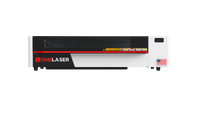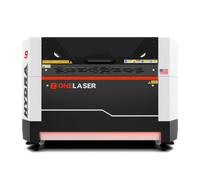When comparing laser cutting and engraving technologies, understanding the role of an RF laser cutter is essential. Unlike standard DC laser cutters, RF laser systems offer enhanced precision, longer lifespan, and superior engraving quality.
This article breaks down what makes an RF laser cutter distinct, how it differs from DC laser engraving systems, and why it matters for businesses that prioritize sharp detail and operational stability.
Key Takeaway
RF laser cutters offer superior engraving precision, longer lifespan (10,000–20,000 hrs), and lower maintenance compared to DC systems. Ideal for professional and industrial use, they deliver consistent, high-detail results across materials like acrylic, leather, and anodized aluminum—making them the best choice for businesses needing reliability and sharp output.

1. What Is an RF Laser Cutter?
RF (Radio Frequency) laser cutters use metal-encased CO₂ laser tubes powered by radio frequency excitation rather than direct current.
1.1 Core Mechanism:
RF laser tubes ionize gas using radio waves, creating a stable laser beam. Unlike DC (Direct Current) tubes that rely on high-voltage electrodes, RF excitation energizes the laser gas through a controlled radio frequency signal. This method generates a consistent and pulsed laser beam without the arcing or variability sometimes found in DC systems.
RF tubes are fully sealed and metal-encased, preventing contamination or gas leakage over time, making them more reliable for industrial use.

1.2 Beam Quality:
Produces a smaller spot size and more consistent output compared to DC laser cutters. RF laser cutters deliver superior beam control due to stable energy delivery and finely tuned pulse frequency.
The result is a tighter focus and cleaner edge definition, particularly noticeable in fine vector cuts, detailed engraving, and micro-marking tasks.
Where DC tubes often produce a wider beam spot that varies with tube age and temperature, RF tubes maintain consistent beam quality across their entire lifespan.
1.3 Typical Applications:
Fine engraving, precision cutting on thin materials, medical-grade manufacturing. RF laser cutters are favored for applications where edge quality, repeatability, and precision detail are mission-critical. This includes:
- Micro-text and serial number engraving on electronic components.
- High-end signage or branding plates requiring flawless finish.
- Medical device components where tolerance control is essential.
- Luxury goods customization, such as engraving on coated metals or precision leather cutting.
RF laser cutters fill a professional-grade role where consistent, high-detail output is required and where machine uptime and reliability directly impact production efficiency.
1.4 Why RF Laser Cutters Deliver Superior Engraving Quality
An RF laser engraver produces cleaner, sharper engravings due to stable beam characteristics.
- Smaller Beam Spot: Ideal for small text, intricate logos, or micro-marking.
- Consistent Pulse Control: RF excitation allows better pulse frequency management for fine shading and detail.
- Application Scope: High-end signage, industrial labeling, and premium product personalization benefit most from rf laser engravers.
2. Advantages of Using an RF Laser Cutter
RF technology brings several operational and quality-of-life advantages beyond engraving clarity. These benefits make RF laser cutters especially appealing for professional and industrial environments where reliability and precision are key.
2.1 Longevity
Metal tubes resist gas leaks and component degradation. RF laser tubes typically last between 10,000 and 20,000 operational hours, significantly longer than the 2,000–4,000 hours expected from glass DC tubes.
The metal and ceramic construction of RF tubes prevents common issues such as gas contamination, electrode wear, or cracks in the tube housing.
This extended service life reduces downtime and replacement frequency, improving return on investment for businesses.
Learn more: RF CO2 Laser Vs Glass Tube CO2 laser - Which Better?

2.2 Low Maintenance
No need for constant refilling or alignment adjustments. RF laser cutters operate as closed, factory-sealed units that require less day-to-day upkeep compared to DC systems.
With no exposed glass tubes or water-cooling loops, users avoid routine issues like coolant leaks, mineral deposits, or electrode corrosion.
Optical alignment remains stable over time, and regular care is typically limited to cleaning external lenses and maintaining airflow.
Learn more: Laser Engraver Maintenance - 6 Essential Parts to Clean
2.3 Energy Efficiency
Lower heat load means reduced cooling and energy costs over time. RF laser cutters generate less residual heat compared to DC systems, which require external water chillers.
Many RF systems use air-cooled designs or integrated cooling modules that consume less power while maintaining operational stability.
This translates into lower overall energy bills and a smaller footprint for cooling equipment, especially important in production environments with multiple machines.
2.4 Safety and Clean Operation
Sealed RF tubes have lower risk of breakage or contamination compared to glass DC tubes. The metal casing protects the internal components from impact damage and environmental exposure.
There is also no risk of gas leaks or shattering, which can occur with traditional glass DC tubes under stress or improper handling. This enhances safety for operators and ensures compliance with workplace safety standards in regulated industries like medical device manufacturing or aerospace component engraving.
These advantages position RF laser cutters as the preferred choice for businesses requiring stable, clean, and long-lasting laser performance across a wide range of materials and applications.
Learn more: Laser Engraving Safety Guide & Tips
3. RF Laser Cutter vs. DC Laser Cutter: Key Differences
Understanding the difference between an RF laser cutter and a DC laser engraver is essential for selecting the right system based on your material needs, production volume, and budget.
While both operate using CO₂ laser technology, the way their laser tubes generate and manage energy differs significantly, affecting performance, lifespan, and operating costs.
3.1 Tube Construction
RF (Radio Frequency) laser cutters use metal-encased laser tubes with ceramic and metal interior components. These tubes are factory-sealed and do not require manual refilling or adjustments.
In contrast, DC laser cutters rely on glass tubes filled with a CO₂ gas mixture. While glass DC tubes are cheaper to produce, they are more fragile and prone to gas leaks or tube cracking. This structural difference directly impacts durability and reliability.

3.2 Cost Considerations
RF laser cutters have a higher upfront cost—commonly ranging from $10,000 to $50,000 depending on power rating and bed size. However, this initial investment is balanced by reduced maintenance needs, fewer tube replacements, and more consistent production output.
DC laser systems, priced around $3,000–$15,000, are more accessible for hobbyists or small-scale operations but come with recurring replacement and maintenance expenses that add up over time.
3.3 When to Choose an RF Laser Cutter Over DC Laser Engraving
While DC laser engraving machines remain popular for budget-conscious users or entry-level hobbyists, RF systems excel in specific professional and industrial scenarios where precision, durability, and throughput matter most.
Ideal Applications for RF Laser Cutters:
- Precision Engraving with High Detail Requirements: RF cutters provide a smaller, more stable beam spot ideal for micro text, intricate logos, or fine vector work on delicate materials.
- High-Volume Production: For businesses producing repeatable parts, nameplates, or branded products in large batches, RF systems deliver consistent quality without frequent downtime.
- Sensitive or Thin Materials: Materials like leather, acrylic, coated metals, or fabrics benefit from RF's stable pulse control, which minimizes edge burning and improves engraving clarity.
Not Ideal for:
- Basic Cutting Tasks on Thick Materials: If your work primarily involves cutting thick wood or multi-layer materials where engraving detail is less critical, a DC laser cutter may be sufficient.
- Startups on a Limited Budget: For hobbyists or small businesses testing the market, a lower-cost DC machine offers an accessible entry point despite its shorter lifespan and higher maintenance needs.
By combining both the technical breakdown and application context, you can make informed decisions about which laser technology best fits their production goals. RF laser cutters stand out where quality, consistency, and reduced maintenance take priority, while DC systems serve well in cost-sensitive, lower-volume environments.
4. Material Compatibility with RF Laser Cutters
RF laser cutters work with a broad range of materials, similar to DC systems but with finer control. The key difference lies in beam stability and pulse modulation, allowing RF systems to process delicate or detailed applications more precisely.
Common Supported Materials:
- Acrylic: RF laser cutters produce flame-polished edges on cast and extruded acrylic. They excel at engraving fine text or graphics on acrylic signage and awards without creating cloudy edges or surface defects.
- Wood: Suitable for cutting and engraving softwoods, hardwoods, plywood, and MDF. RF systems produce cleaner, more detailed engravings on wooden surfaces, especially for intricate patterns or raster shading
- Leather: RF cutters are ideal for processing both natural and synthetic leathers, offering precise edge cuts without excessive charring or burning, which is a common issue with lower-quality systems
- Paper: Capable of cutting and engraving paper, cardstock, and cardboard with minimal edge burn. RF's controlled pulse energy ensures fine cuts without igniting thin paper layers.
- Anodized Aluminum: RF systems can engrave high-contrast markings on anodized surfaces. This is particularly useful for industrial tags, labels, and serialized components.
- Rubber: Engraving and cutting stamp rubber and gasket materials are more consistent with RF systems. Controlled power levels minimize edge deformation and improve repeatability.
Learn more: Laser Cutter, Engraving Settings for Different Materials
Performance Notes:
- RF systems handle thin plastics and coated materials better due to controlled pulse energy. For example, thin polycarbonate or PET sheets can be engraved or kiss-cut with less risk of edge warping compared to DC systems.
- Consistency across repeat jobs is higher compared to DC laser cutters. RF's beam stability ensures that every pass delivers uniform results, even over long production runs. This reduces scrap rates and improves reliability in professional settings.
By leveraging RF laser cutters' precision beam control, users can expand their material range without sacrificing quality or repeatability, making them a preferred choice for high-detail engraving and cutting across multiple industries.
5. How to Maintain and Optimize an RF Laser Cutter
RF tubes may require less maintenance than DC systems, but proper care still extends their operational life and ensures consistent performance. Regular maintenance minimizes downtime, protects laser components, and helps maintain engraving and cutting quality over time.
5.1 Maintenance Checklist
- Keep optics clean: Regularly inspect and clean lenses, mirrors, and the nozzle using appropriate lens wipes or optical cleaning solutions. Even minor dust or residue buildup can reduce beam power and degrade engraving sharpness. Clean optics weekly in high-use environments.
- Ensure airflow and fume extraction are unobstructed: Check that air assist lines, exhaust fans, and fume extraction systems remain clear of blockages or buildup. Restricted airflow can lead to overheating, poor cut quality, or damage to internal components.
- Periodically check tube alignment and output power using diagnostic tools: Over time, vibrations or material handling can shift laser tube positioning. Use beam alignment cards and power meters to verify beam alignment and consistency. Adjust mirrors and mounts as needed.
- Store and operate the machine in a dust-controlled, temperature-stable environment: Keep the workspace clean and maintain a consistent room temperature between 15°C–25°C. Avoid exposing the machine to excessive humidity or dust, as both can affect the longevity of electrical and optical components.
Following these steps helps maximize the lifespan of your RF laser cutter while ensuring professional-quality output on every job.
FAQs
Q1. What's the primary advantage of an RF laser cutter?
The primary advantage of an RF laser cutter is its beam stability and engraving precision. RF laser engravers produce a smaller, more consistent spot size than DC laser cutters, resulting in cleaner, sharper details, especially for small text, fine lines, and intricate patterns. Additionally, RF tubes offer longer service life and lower maintenance requirements due to their sealed metal construction.
Q2. How long does an RF laser tube last?
An RF laser tube typically lasts between 10,000 to 20,000 operational hours, depending on the system's power rating and usage conditions. This is significantly longer than a DC laser tube, which usually lasts around 2,000 to 4,000 hours. Regular maintenance, such as cleaning optics and ensuring proper airflow, helps maximize RF tube lifespan.
Q3. Can I upgrade a DC laser engraver to an RF system?
No, in most cases, upgrading a DC laser engraver to an RF system is not feasible. RF laser tubes require different power supplies, control boards, and mechanical mounts. The differences in tube construction and electrical requirements mean switching from DC to RF would require a nearly complete machine rebuild. It's generally more practical to invest in a dedicated RF laser cutter.
Q4. Is an RF laser cutter suitable for metal engraving?
RF laser cutters are suitable for engraving on coated or anodized metals, such as anodized aluminum, painted stainless steel, or laser-marking sprays applied to metal surfaces. However, RF CO₂ lasers are not effective for direct cutting or engraving bare metals. For direct metal cutting or uncoated metal marking, a fiber laser system is required.
Q5. What industries commonly use RF laser engravers?
Industries that prioritize engraving precision and long-term reliability typically use RF laser engravers.
Have Questions? Contact Us Now!
Conclusion
An RF laser cutter isn't just a premium tool—it's a necessity for businesses where detail, reliability, and longevity matter. While DC laser engraving machines serve budget-conscious and hobbyist markets well, RF laser engravers provide unmatched engraving sharpness, machine uptime, and consistent output. If you need a durable, scalable solution for professional engraving and precision cutting, investing in an RF laser cutter positions your operation for long-term growth and competitive quality.

 Liquid error (sections/image-banner line 171): invalid url input
Liquid error (sections/image-banner line 171): invalid url input





